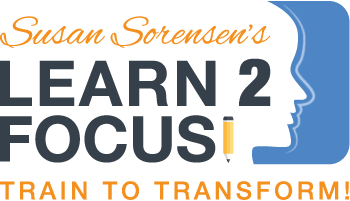The Recipe for Making Changes in Your Brain
/Real change requires a real plan.
A recipe for success.
Making changes in your brain is no different.
Brain training is that blue ribbon recipe.
It incorporates a specific mix of interactive and instructional ingredients that support proven methods of successfully improving the way you process, learn, read, or recall information.
Consider the five-part mix:
Ingredient 1. Frequency — stimulation of specific and relevant brain functions is applied on a regular basis for appropriate brain training to occur and significant engagement to take place.
Ingredient 2. Intensity — layer training time to target and incorporate brain functions or areas of focus that are blocked and need to be optimized.
Ingredient 3. Duration — provide appropriate and plentiful input so that the brain receives a significant dosage of concentrated training per targeted brain function
Ingredient 4. Consistency — maintain ongoing practice for ongoing benefit. Brain training is not a one-time process. Continual practice must be employed to maintain lifelong gains.
Ingredient 5. Challenge — adapt challenge and difficulty. Interactive, computerized brain training allows monitored, adaptable training that will keep training going without becoming dull or frustrating.
This brain training recipe is critical for lasting change.
So, how does it apply to you or your child’s specific challenges?
There are a lot of brain training options.
How exactly should you use the five ingredients?
Choosing a method or technological option should center on your training goals and the brain functions that require improvement.
At Learn2Focus the brain training recipe can be applied in a variety of scientifically proven programs. What diagnosis have you been managing? ADD/ADHD, Autism Spectrum Disorder, Apraxia/Dyspraxia, Dyslexia, Auditory and Sensory Processing Disorders?
Are there literacy problems? Would you like to boost focus on the court or on the field?
Discuss the following Learn2Focus options with a clinician, and choose the right brain training method for you. Our programs include:
- Interactive Metronome — IM has an auditory-visual platform that engages the patient like a video game. Sending feedback by the millisecond, it helps synchronize brain timing. Able to be customized and adjusted for complexity, IM improves cognitive processing, attention and decision-making through rhythms and movement.
- CogMed — CogMed uses 25 online training sessions, each 55 minutes long, to target the different aspects of working memory. Over the course of five weeks, the rigorous, systematic training can conveniently be completed online anywhere. Additional training protocols are also available for individuals who don't have the time to commit to training 5 days a week.
- FastForWord — FastForWord employs computerized activities to help users identify computer-generated speech sounds. Most participants spend half an hour to 90 minutes daily, five days a week, for 8 - 16 weeks, training through drills to improve temporal processing. It is different from other reading interventions because it strengthens the key pathways in the brain which help students learn - Memory, Attention, Processing, Sequencing.
- InTime — InTime stimulates different brain areas and their coordinating functions during personalized listening schedules, using continuous, escalating rhythm-based training across four frequency zones.
- The Reading Assistant — RA unique technology which targets fluency, allows users to receive real-time comprehension feedback and correction through speech recognition anytime, anywhere, online, and on demand. Readers are able to correct themselves more readily when reading aloud. Reading experts agree that fluency is an important key to unlocking reading comprehension.
- The Listening Program — TLP users listen to evidence-based instrumental soundtracks through bone conduction headphones. TLP's proprietary ABC (Accommodation-Training-Integration) Modular Design guides the listener through multiple levels of sound training during each session to lower stress and support focus, self-regulation and control, learning, and recall. Students typically use the program 15 to 60 minutes, 5 days per week for 4-6 months, revisiting the program as needed afterward to address specific needs and goals.
- Moyer’s Learning Ears — Learning Ears emphasizes ear-voice training. Music/sound stimulation and audio-vocal training are used to retrain auditory perception and translation, improving accuracy and self-correction. The 20-week program commits students to work 30 minutes, 5 days a week targeting specific skill developments in four phases.
Once your choice is made, you may begin the exciting process of actually retraining the way the brain operates and enjoying the growth you or your child longs for.

